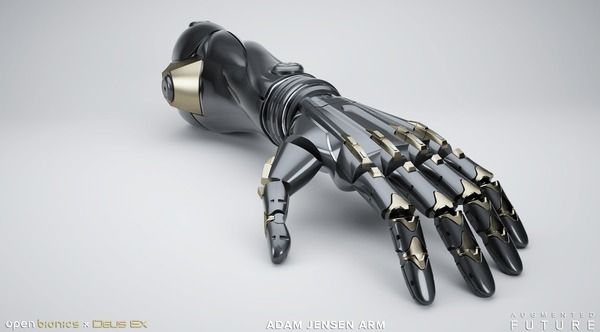Archive for the ‘entertainment’ category: Page 106
Aug 19, 2016
Augmented Reality Or Augmented Humanity?
Posted by Zoltan Istvan in categories: augmented reality, entertainment

A write-up from Popular Science on the bioethics conference I was a part of recently and the corresponding 2-min highlight video. It was truly a fascinating event, inspired by Deus Ex! http://www.popsci.com/augmented-reality-or-augmented-humanity And here’s the video: http://www.dailymotion.com/video/x4p7uld_human-by-design-conference-recap_tech
With the release of the new video game, Deus Ex: Mankind Divided, Human By Design holds a conference to discuss the future of human augmentation.
Aug 17, 2016
Adults acting like toddlers because of technology obsession, warns neuroscientist
Posted by Karen Hurst in category: entertainment
Adults are starting to behave like toddlers as social media and video games lead to a craving for instant gratification, a leading neuroscientist fears.
Baroness Susan Greenfield, who is a senior research fellow at Oxford University, said the obsession with games like Pokémon Go is causing the “infantilisation” of adulthood.
The trend of shunning the outdoors and live social contact in favour of social media is also contributing to grown-ups exhibiting traits associated with toddlers, including neediness and a short attention span, she added.
Aug 16, 2016
The Use of 3D Printing in Reviving the Statue of Zeus in Olympia
Posted by Karen Hurst in categories: 3D printing, entertainment
Wonder when someone will attempt to 3D Print Atlantis; or recreate the ancient Colossus of Rhodes.
Rio 2016 is a much-awaited event of people from all over the world that has already been happening in Brazil. On the other hand, the Summer Olympics that was held in Atlanta in 1996 has celebrated their 20th anniversary by creating a replica of Zeus using 3D printing technology. The statue of Zeus that was taken from Olympia is commonly used to represent the Olympics. As a matter of fact, it is also considered as a part of the Seven Wonders of the ancient world.

Continue reading “The Use of 3D Printing in Reviving the Statue of Zeus in Olympia” »
Aug 16, 2016
The First Arrival Trailer Makes Talking to Aliens Terrifying
Posted by Sean Brazell in categories: alien life, entertainment
Absolutely, undeniably awesome.
We got about a minute of footage last week, and now the full trailer for the movie adaptation of Ted Chiang’s “Story Of Your Life” is here. And it is tense.
Whereas before, the footage ended with Amy Adams’ Dr. Banks getting her first look inside one of the weird alien monoliths that have appeared, the trailer goes much further. We see her actually communicating with the aliens, while the rest of the world goes appropriately batshit. There’s a lot less action in this sci-fi movie than there is drama, and it all looks great.
Continue reading “The First Arrival Trailer Makes Talking to Aliens Terrifying” »
Aug 13, 2016
DeepDrive: People at research labs are supposedly playing around with testing their AI’s in current gen
Posted by Dan Kummer in categories: entertainment, neuroscience, robotics/AI

Video games. The last i heard AI had been up to playing and Mastering Atari 2600 games, and that was a few years ago. Figured it was only a matter of time til they started playing around with current gen stuff.
Neural net driving in GTAV — View all crizcraig’s Rockstar Editor videos at http://socialclub.rockstargames.com/member/crizcraig
Aug 9, 2016
The First Footage From Arrival is Here, and It Looks Incredible
Posted by Sean Brazell in category: entertainment

Finally a trailer for this!
And it looks like it’s been worth the wait!
Continue reading “The First Footage From Arrival is Here, and It Looks Incredible” »
Jul 26, 2016
Literature and film help teach students to understand the brain
Posted by Karen Hurst in categories: entertainment, neuroscience
UCLA freshman cluster course combines anatomy, history, philosophy and humanities to provide an interdisciplinary approach to studying neuroscience.
Jul 26, 2016
Scientists create glasses-free 3D for the movie theater
Posted by Shailesh Prasad in categories: entertainment, futurism

Watching glasses-free 3D on a TV is no longer an outlandish concept, but that hasn’t been true for movie theaters. How are you supposed to create the same parallax effect for everyone, whether they’re up front or way in the back? Researchers at MIT CSAIL and Israel’s Weizmann Institute for Science finally have a practical answer. Their Cinema 3D tech creates multiple parallax barriers in a single display, using lenses and mirrors to deliver a range of angles across the whole theater. And unlike previous attempts at large-scale glasses-free 3D, you don’t have to take a hit to resolution.
You won’t get to forego the unwieldy eyewear for a while. The prototype is only slightly larger than a pad of paper, and uses 50 lens/mirror combos to achieve its 3D effect. You’d need a far bigger and more intricate system to make it work at the local movie house, which might make it prohibitively expensive. However, it’s imaginable that a future, optimized version might find its way into theaters and spare you from one of the biggest hassles in modern moviegoing.
Continue reading “Scientists create glasses-free 3D for the movie theater” »
Jul 25, 2016
Making Jupiter into a Star
Posted by Andreas Matt in categories: alien life, entertainment, nuclear energy
Interesting…
The SETI concepts now called ‘Dysonian’ are to my mind some of the most exhilarating ideas in the field. Dysonian SETI gets its name from the ‘Dyson spheres’ and ‘Dyson swarms’ analyzed by Freeman Dyson in a 1960 paper. This is a technology that an advanced civilization might use to harvest the energy of its star. You can see how this plays off Nikolai Kardashev’s classification of civilizations; Kardashev suggested that energy use is a way to describe civilizations at the broadest level. A Type II society is one that can use all the energy of its star.
In the film 2010, director Peter Hyams’ 1984 adaptation of Arthur C. Clarke’s novel 2010: Odyssey Two (Del Rey, 1982), we see an instance of this kind of technology at work, though it has nothing to do with a Dyson sphere. In the film, a dark patch appearing on Jupiter signals the onset of what Martyn Fogg has called ‘stellification,’ the conversion of a gas giant into a small star. Rapidly replicating von Neumann machines — the famous monoliths — increase Jupiter’s density enroute to triggering nuclear fusion.













